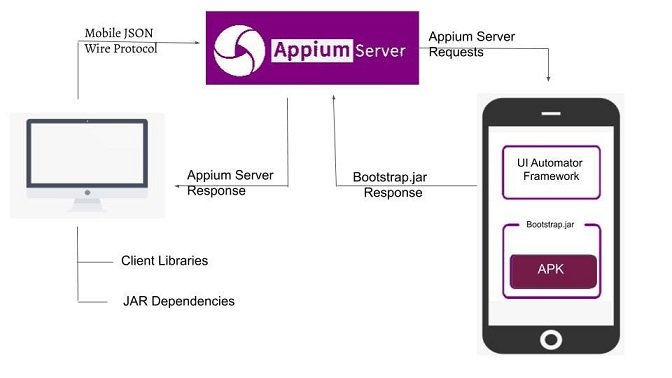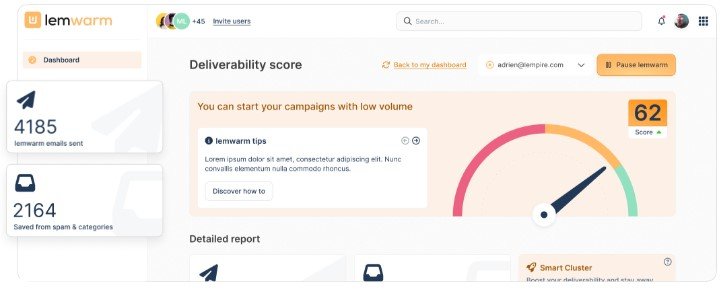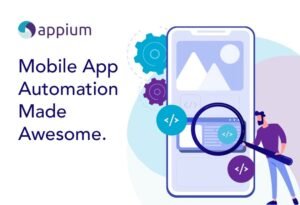The drastic expansion and advancement in the mobile testing market have stimulated the need for future-ready smartphones. Mobile app testing is considered an integral part of the development cycle to validate efficiency and ensure the intended functionalities are properly met.
The dynamic software environment revolutionized the trend of mobile app testing. In contrast to manual mobile app testing tools and frameworks, automated testing tools such as Appium make testing smooth and uncomplicated. Appium, an open-source, cross-platform test automation tool, stands as an exquisite solution owing to its cross-platform compatibility while concurrently focusing on consistency, efficiency, and reliability.
Understanding the architecture of Appium would precisely streamline the testing process at various stages. This article will specifically explain the Appium architecture for seamless mobile testing.
Appium – An Overview
Appium is an open-source, cross-platform solution for automated testing. Its main focus is offering a smooth automation testing experience on mobile apps running on iOS and Android.
A few years ago, Appium was solely a CLI tool installed primarily through the node package management. Recently, the Appium developer team has launched a desktop application with a graphical user interface (GUI) that can be installed on several Linux distributions, Microsoft Windows, and Mac OS X.
Appium is a web server that uses WebDriver protocol. The WebDriver protocol gained so much traction that the World Wide Web Consortium (W3C) incorporated it into every web browser. The W3C is the standard body for web browsers, HTML, and CSS. Consequently, by default, all major browsers now support this protocol.
Appium is said to be a cross-platform application because,
- It can be used to test mobile applications, both on iOS and Android.
- It can be used to test Hybrid, Native, and Web Applications.
- It can run on Windows, Linux, and MAC.
Appium Concepts
Before knowing in detail about the architecture of Appium, let us know the concepts involved. Below are the three intrinsic concepts involved in the Appium architecture.
Appium Client-Server Architecture
Appium is a server written in node.js. The server works by using a typical client-server model. In the client-server architecture, the client connects to the server to fetch any of the services hosted on the server. The client and server communicate in the form of responses and requests. In Appium, the client requests automation from the Appium server. The server processes the request quickly and sends a response as log files.
Appium Sessions
Testing is done encapsulated in a session. Since Appium is a simple client and server-based mechanism, the client sends post requests or session requests to the server. These requests have data in a JSON Object format, and communication is mainly done using JSON Wire protocol.
Desired Capabilities
Appium works differently on iOS and Android. Since it is a cross-platform tool, a mechanism must be present to distinguish the session requests. Desired Capabilities are nothing but key-value pairs of data that differentiate sessions for testing an Android app from that of an iOS app.
With arguments like-
- platformName
- deviceName
- appPackage
- appActivity
The distinction between iOS and Android testing can be easily made.
Understanding the Architecture
Appium holds a transparent architecture that emphasizes cross-platform mobile applications. To delve deeper into the architecture, an in-depth understanding of its respective components is essential. At the core, Appium is a client-server architecture written in the node.js format, according to which services are communicated and availed.
To be simple, Appium’s architecture mainly has three components:
- Appium Client
- Appium Server
- End Device
Other concepts, such as JSON Wire protocol and Bootstrap.js, are essential helping components that bridge the Appium client and server. Let us see each of the components and the workflow in detail.
Appium Client
- The client is a software program that requests services to the server. Such requests sent by the client to the server are known as session requests.
- All the successive session requests from the client are provided with unique session IDs within the created session.
- The session requests that communication between client and server be carried out by following the JSON wire protocol.
- During communication by the client, the data/request from the client is converted into a JSON object owing to the JSON wire protocol.
JSON Wire protocol
- In simple terms, JSON wire protocol establishes a set of ground rules for communication between the client and server as a RESTful API.
- JSON Wire protocol shall be interpreted as a bunch of endpoints exposed to the client via a RESTful API, enabling communication and automation within the architecture.
- RESTful API can be understood as an application programming interface that obeys the principles of Representational state transfer in a client-server architecture.
- Appium employs JSON wire protocol, an extension of the Selenium JSON wire protocol.
Appium Server
- The Appium server is said to be the foundation of the Appium mobile testing architecture.
- This is the component in which the requests from the client in the JSON object format are interpreted to perform the intended actions.
- The first request pushed to the server from the client is said to be a POST request to the endpoint, from which the session ID is created and maintained until the mobile testing process is complete.
- The server also acts as a translator, translating the MJWP commands to its understandable native commands concerning the type of automation framework/OS used.
- Appium mobile testing can be carried out on either Android or iOS.
Bootstrap.jar
- Bootstrap.jar generally bridges the Appium server and the UI Automator framework, facilitating communication and automation in the mobile testing process.
- The bootstrap.jar runs as a TCP server awaiting the MJWP commands from the Appium server.
- Further, the bootstrap translates into appropriate UIAutomator commands and forwards it to the UI Automator framework, where the automation job occurs.
- After successful automation via command execution, the test script is sent back to the client for further scrutiny over bootstrap.jar.
- Bootstrap.jar can be only employed for Android OS and can be automatically managed by Appium during the session setup process.
- It bridges the gap between the server and the device for seamless testing.
End Device
- In Appium, the “end device” refers to an, or simulator, connected to the server where automated mobile app testing is executed.
- On the other hand, the end device for different operating systems varies.
- These devices play a crucial role in carrying out the testing procedures and validating the functionality and performance of mobile applications.
Appium on Android and iOS
Appium has minor differences when it comes to execution on Android and iOS. In this section, let us see how the processes differ.
Appium on Android
- Appium on Android is powered by the UI Automator framework designed for Android automation.
- In Android, Appium uses UIAutomator2 or Appium Driver to communicate with the Android elements and mobile testing.
- The communication in Appium client-server architecture is performed by considering the JSON wire protocol.
- The server interprets the desired capabilities encapsulated as a request from the client. The server generates an automation session using Web Driver and then connects as per the UI Automator framework.
- One of the essential concepts in the UI Automator is its integration with bootstrap.jar.
Appium for iOS
- Appium uses Apple’s XCUI test API to automate and communicate with the UI elements in iOS.
- The test commands you carefully craft are expertly wrapped into a JSON object by the Appium client libraries. This acts as a neat package for transport.
- This JSON package is transported to the Appium server, riding the efficient Mobile JSON Wire Protocol.
- Upon arrival, the Appium server enlists the help of WebDriver, which swiftly sends the commands to their final destination: the connected iOS device or simulator.
- In the device, the WebDriverAgent.app eagerly awaits the commands. It acts as a translator, skillfully converting them into commands the device understands using the XCUITest framework.
- With the commands, XCUITest, a powerful test execution framework, diligently performs the interactions you specified in your test scripts.
- Once the tests complete their mission, the WebDriverAgent.app gathers the results and sends them back to the Appium server and the client to evaluate the outcomes.
Advantages of Appium’s Architecture
Here are the advantages of Appium’s architecture, making it widely acceptable and trending in the testing industry.
- Cross-Platform Compatibility: One of the key features of Appium’s architectural strength is its ability to run tests on both iOS and Android easily. Developers may guarantee consistent application behavior across various mobile OS systems by employing a single set of tests.
- Standardized Automation APIs: Appium uses UI Automator for Android and XCUITest for iOS as standard automation APIs to interface with mobile devices. The testing tool and the mobile platforms have a strong and dependable connection to approved guidelines.
- Open Source and Community-Driven: Appium benefits from a cooperative community because it is an open-source framework. Developers’ contributions enable continuous growth and refinement, creating a feature-rich and dynamic testing tool.
- Flexibility with Languages: Appium is compatible with programming languages, including Java, Python, Ruby, and C#. This facilitates workflow incorporation by enabling development teams to utilize specific programming languages.
- Flexible Testing Environments: Appium supports emulators and simulators in addition to real devices for testing. Its adaptability guarantees thorough testing in various settings, including virtual and real surroundings. One such real device cloud that is being extensively used for Appium testing is LambdaTest.
Appium, an open-source automation framework, simplifies the integration of cloud testing platforms like LambdaTest. LambdaTest is an AI-powered test orchestration and execution platform that lets you run manual and automated tests at scale with over 3000+ real devices, browsers, and OS combinations. This platform delivers a seamless and scalable solution for mobile application testing. It is a cloud-based testing platform that presents a diverse array of real device cloud browsers and devices, catering to testing needs across varied environments.
This amalgamation significantly improves the testing workflow by providing flexibility, scalability, and access to an extensive range of testing environments, ultimately contributing to more robust and comprehensive mobile application testing procedures.
- Non-intrusive approach: One notable aspect of Appium’s architecture is its ability to perform testing without changing the original application’s source code. With less complexity to the development life cycle, this non-intrusive approach tests new and current applications more easily.
Conclusion
In conclusion, the well-defined architecture of Appium shines as a beacon of efficiency and ease in the vast landscape of mobile app testing. Its client-server model, robust protocols, and dedicated frameworks create a seamless communication chain between your test scripts and the target device.
Whether Android’s bootstrap.jar acts as a translator or iOS’s WebDriverAgent deciphering commands, each component plays a crucial role in orchestrating a flawless automation symphony. Appium’s flexibility, extensibility, and open-source nature further elevate its appeal, making it a powerful ally in delivering quality and speed to your mobile testing endeavors. So, embrace the elegance of Appium’s architecture and watch your mobile testing soar effortlessly to new heights.





















